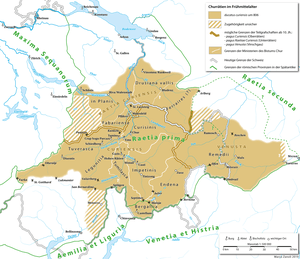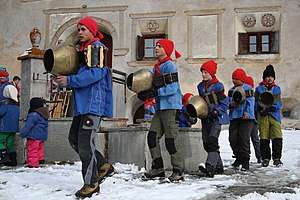Romansh people
The Romansh people (also spelled Romansch, Rumantsch, or Romanche; Romansh: rumantsch [rʊˈmantʃ] (![]()
![]()
![]()
Distribution of L1 Romansh speakers in Grisons (municipalities with more than 25% L1 speakers are shown), as of 2000. | |
| Total population | |
|---|---|
| c. 45,000 | |
| Regions with significant populations | |
| c. 30,000 (2017)[1] | |
| c. 5,000 (2017)[1] | |
| Languages | |
| Romansh, Swiss German | |
| Religion | |
| Christianity (majority Roman Catholic, Swiss Reformed) | |
| Related ethnic groups | |
| other Swiss; Friulians, Ladin people; Lombards | |
The Romansh speaking population is collectively known as Rumantschia in Romansh (alternatively rumantschadad, Vallader: rumantschità, Sursilvan: romontschadad) . This term has come to replace the German official legal term of "Gemeinschaft der Bündner Romanen" introduced in 1982.[4]
As of 2017, they make up close to 45,000 inhabitants of Switzerland, or 0.85% of its population, and close to 30,000 inhabitants of the canton of Grisons (or 14.7% of Grisons' population).[5][1]
About 28% of the Romansh-speaking people in the Grisons also speak at least one other language fluently: mainly German or Italian, which are the other official languages of Grisons.[6]
History

The territory of Switzerland was Romanized in the 1st to 3rd centuries AD, and its population spoke a form of Vulgar Latin by the time of the collapse of the Western Roman Empire in the 5th century. The province of Raetia prima, established c. 300 (under Diocletian) became known as Raetia Curiensis, ruled by the bishops of Chur throughout the 5th to 12th centuries (albeit nominally part of the Duchy of Swabia from the 10th century). This included Sarganserland (now Canton of St. Gallen), as far as Lake Walen and the Linth River, the Ill basin in what is now Vorarlberg, and the upper Vinschgau in what is now South Tyrol.
Rhaeto-Romance linguistic unity broke down from the end of the Carolingian period, with the establishment of the imperial counties of Werdenberg and Tyrol to the north and east, and the March of Verona to the south. Nominally under Frankish rule from the 6th century, the local bishops of Chur still retained de facto control. In the mid-8th century a surviving Lex Romana Curiensis, a "Roman Law of Chur", was an abbreviated epitome of the Breviary of Alaric. After the death of the last Victorid bishop Tello of Chur in 765, King Charlemagne took the occasion to issue a document of protection declaring Tello's successors his vassals. From the 770s onwards, Charlemagne appointed the bishops of Chur himself, increasing Frankish control over the territory. Upon the death of Bishop Remedius in 806/7 he legislated a division between episcopal and comital property, ending the de facto secular rule of the Chur bishops. He appointed Hunfriding counts, but the ecclesiastical and secular claims to power remained a source of contention. The Hunfriding count Burchard II was able to proclaim himself a duke of Swabia in 917.
In the high medieval period, with the advance of Alemannic Germans, the linguistic boundary of Latin (Romance) speakers was pushed back to what would become Grisons (the Three Leagues). Sargans was part of the county of Werdenberg from the 12th century. The territory of Grisons, the southern part of Raetia Curiensis (in the medieval period known as Upper Raetia, Raetia superior, Oberrätien)[7] remained predominantly Latin-speaking throughout the early modern period (with the exception of the high pastures settled by the Walser).
When Grisons became part of Switzerland in 1803, it had a population of roughly 73,000, of whom around 36,600 were Romansh speakers—many of them monolingual—living mostly within the Romansh-speaking valleys.[8] The number of Romansh speakers has remained roughly constant since that time (while, in the same period, the population of Switzerland has nearly quintupled).
The language border with German, which had mostly been stable since the 16th century, now began moving again as more and more villages shifted to German. One cause was the admission of Grisons as a Swiss canton, which brought Romansh-speakers into more frequent contact with German-speakers. Another factor was the increased power of the central government of Grisons, which used German as its administrative language.[9] Some people even welcomed the disappearance of Romansh, in particular among progressives. In their eyes, Romansh was an obstacle to the economic and intellectual development of the Romansh people.[10]
Around 1880, the entire Romansh-speaking area still formed a single continuous geographical unit. But by the end of the century, the so-called "Central-Grisons language bridge" began to disappear.[11] Rumantschia lost its contiguity in the early 20th century, with the weakening of Sutsilvan in the Posterior Rhine valley.
Sutsilvan is now limited to some 1,000 speakers concentrated in a language island on the left bank of the Posterior Rhine, centered on Casti-Wergenstein (the former Schams subdistrict).
Starting in the mid-to-late 19th century, a revival movement began, often called the "Rhaeto-Romansh renaissance". In 1919, the Lia Rumantscha was founded to serve as an umbrella organization for the various regional language societies. In 1937 the Swiss government proposed the recognition of the Romansh language as Switzerland's fourth national language (alongside German, French and Italian). The political background for this was the irredentist propaganda by Fascist Italy, which claimed Grisons along with the Ticino as ethnically Italian territory. In a popular vote on 20 February 1938, a majority of 91.6% voted for the recognition of Romansh as an official language for use within the canton of Grisons.
Contemporary situation

In the late 1980s and 1990s, debate about the future role of Switzerland within what was going to become the European Union prompted a reawakening of "the long-dormant Romansh national movement". Elements within this movement advocated an ultimate transfer of sovereignty from the Swiss Confederation to a future Federal Europe. A 1996 referendum strengthened the status of Romansh in Switzerland, permitting its use at the federal level.[12]
There is no general sense of unity within "Rumantschia" due to regional separation and dialectal variations. Rumantsch Grischun was an attempt launched in the 1980s to introduce an artificial standard version of Rumantsch; but acceptance of this standard has been limited. There are instead five written dialects, each with its own orthography: Sursilvan, Sutsilvan, Surmiran, Putèr and Vallader.
As of 2000, areas with a majority of native Rumantsch speakers were separated into four disconnected parts: Surselva (Sursilvan, Tuatschin), Schams (Sutsilvan), Albula/Surmeir (Surmiran) and Engadin with Val Mustair (Putèr, Vallader, Jauer).
A renewed effort to introduce course material in Rumantsch Grischun for primary education was started in 2006.[4] A cantonal law of 2006 aims to preserve the trilingual (Romansh, Italian, German) character of Grisons. It prescribes that primary schools, public signage and correspondence by the municipal authorities are to be exclusively in the historically predominant language as long as this language is spoken by at least 40% of the population.
In cases where the population speaking the historically predominant language numbers between 20% and 40%, municipal authorities are obliged to offer official communication and primary education in this language alongside the majority language.
In cases where the fraction of Romansh or Italian speakers is between 10% and 20%, authorities are obliged as a minimum to offer Romansh or Italian as a subject in primary education.[13]
Notable people
- Salis family (Soglio)
- Planta family (Upper Engadin)
- Thomas Planta, bishop of Chur (r. 1549–1565)
- Alfred von Planta
- British librarian and diplomat Joseph Planta (1744–1827) was born at Castasegna, the son of Reverend Andrew (Andreas) Planta (1717–1773). The family moved to London in 1752.
- Jörg Jenatsch (1596–1639), political leader during the Thirty Years' War
References
- "Ständige Wohnbevölkerung nach Hauptsprachen und Kanton" (XLS) (official site) (in German, French, and Italian). Neuchâtel, Switzerland: Federal Statistical Office. 21 February 2019. Retrieved 2019-07-11. 28,699 ± 4.9% (27,300–30,100). The largest community of speakers outside of Grisons, some 5,000 people, is in the canton of Zürich (cited as 5,265 ± 12.6%).
- Minahan, James (2000). One Europe, Many Nations: A Historical Dictionary of European National Groups. Greenwood Publishing Group. p. 776. ISBN 0313309841.
Romance (Latin) nations... Romansh
- Rhaeto-Romance can be classified as either Gallo-Romance, or as a separate branch within the Western Romance languages. Rhaeto-Romance is a diverse group, with the Italian varieties influenced by Venetian and Italian and Romansh by Franco-Provençal.
- Lexicon istoric retic s.v. Rumantschia
- "Ständige Wohnbevölkerung nach Hauptsprachen in der Schweiz" (XLS) (official site) (in German, French, and Italian). Neuchâtel, Switzerland: Federal Statistical Office. 21 February 2019. Retrieved 2019-07-11. cited as 44,354 ± 4.0%. This amounts to a confidence interval of 42,500–46,200.
- "Ständige Wohnbevölkerung ab 15 Jahren nach Anzahl Hauptsprachen und Sprachgebiet" (XLS) (official site) (in German, French, and Italian). Neuchâtel, Switzerland: Federal Statistical Office. 29 January 2019. Retrieved 2019-07-11.
- deinde [appellantur] Raetia Prima et Raetia Secunda, necnon Raetia Alpestria et Raetia Plana vel Campestris, vel Raetia Cana seu Grisaea et Raetia Nova, mox Raetia Superior et Raetia Inferior: atque Alemannia denique et Raetia Curiensis Ulrich Campell (d. 1582), De Raetia ac Raetis liber posterior, ed. P. Plattner, Quellen zur Schweizer Geschichte (1877), p. 58.
- Furer (2005). p. 9
- Furer, Jean-Jacques (2005), Eidgenössische Volkszählung 2000 – Die aktuelle Lage des Romanischen, Neuchâtel: Bundesamt für Statistik, ISBN 978-3-303-01202-4, pp. 9, 23
- Coray, Renata (2008), Von der Mumma Romontscha zum Retortenbaby Rumantsch Grischun: Rätoromanische Sprachmythen, p. 96
- Kraas, Frauke (1992), Die Rätoromanen Graubündens: Peripherisierung einer Minderheit, p. 151
- James Minahan (1 January 2002). Encyclopedia of the stateless nations. 3. L – R. Greenwood. p. 1602. ISBN 978-0-313-32111-5. Retrieved 12 July 2013.
- Sprachengesetz des Kantons Graubünden (SpG; 2006), Art. 16–20 / S. 5 f.